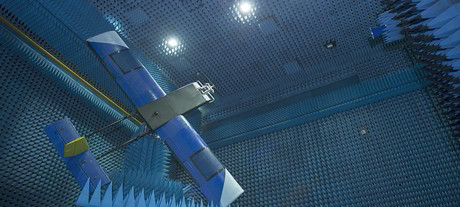Testing steerable satellite antennas for drones

The photo shown here depicts a 6-metre-wingspan unmanned aircraft supported in mid-air within the European Space Agency’s (ESA) Hertz radiofrequency test chamber.
The purpose of the testing campaign is to check that the drone can maintain contact with its controller through satellite links.
The drone, developed by Barnard Microsystems of the UK, has been fitted with a steerable array antenna in its wing to lock on to satellites within the Inmarsat constellation.
This is the focus of ESA’s ESTARR project — Electronically Steered Antenna Array in the Wing of a Remotely Piloted Aircraft — which is investigating the feasibility of a steerable, low-cost array antenna in the drone’s wings.
Designed for oil, gas and mineral prospecting, pipeline surveying and border patrols, the drone will spend most of its time operating far from its controller, often in areas with no communications infrastructure. To ensure the legally mandated link between the remote pilot and the drone is maintained, a satellite data relay service must be used.
The array must electronically sweep its beam rapidly to counteract any movement of the drone, and maintain the all-important control link with space, without any aerodynamic or electronic interference with the functioning of the drone itself.
Testing was performed in ESA’s metal-walled Hybrid European Radio Frequency and Antenna Test Zone at the agency’s technical centre in the Netherlands, shut off from all external influences for radio testing.
Using AI to build your next-gen wireless system
The central challenge engineers face when designing wireless systems and networks is their...
Ensuring 5G network performance
To be successful in business-critical use cases, the wireless networks need to be as reliable as...
Ubiquitous connectivity is the future of wireless
Systems capable of seamlessly using satellite, cellular and local area networks are nowadays a...





